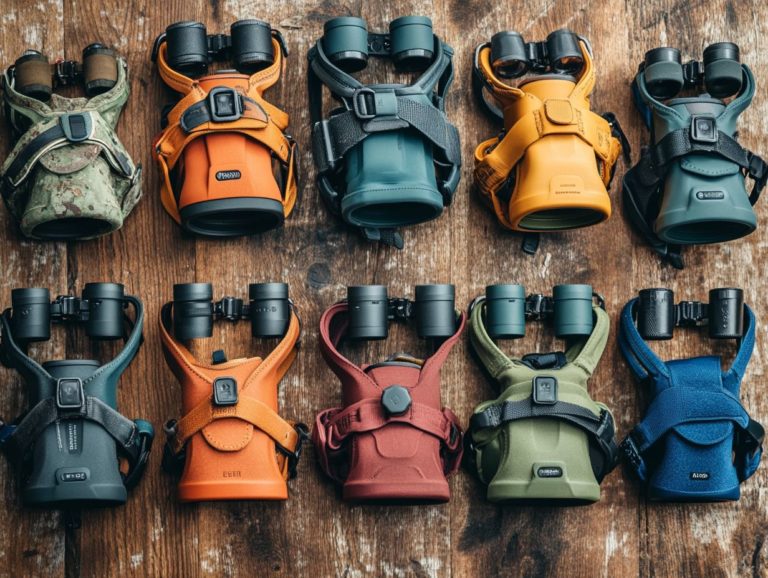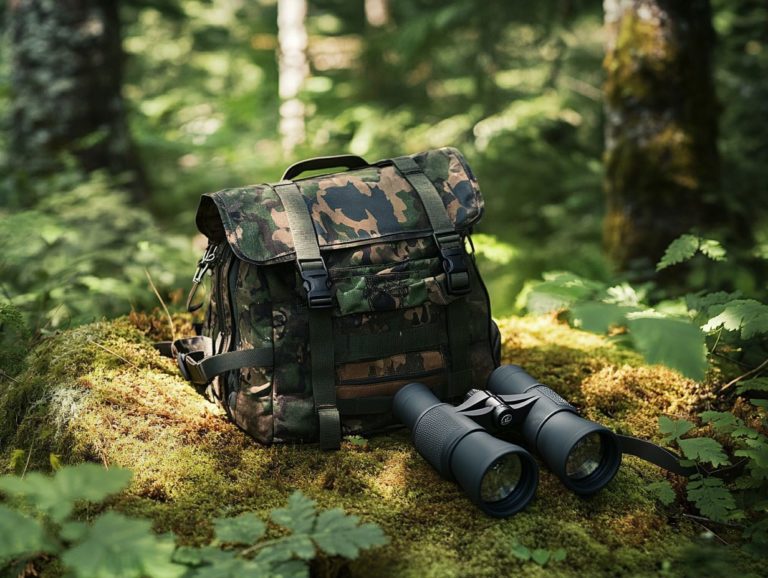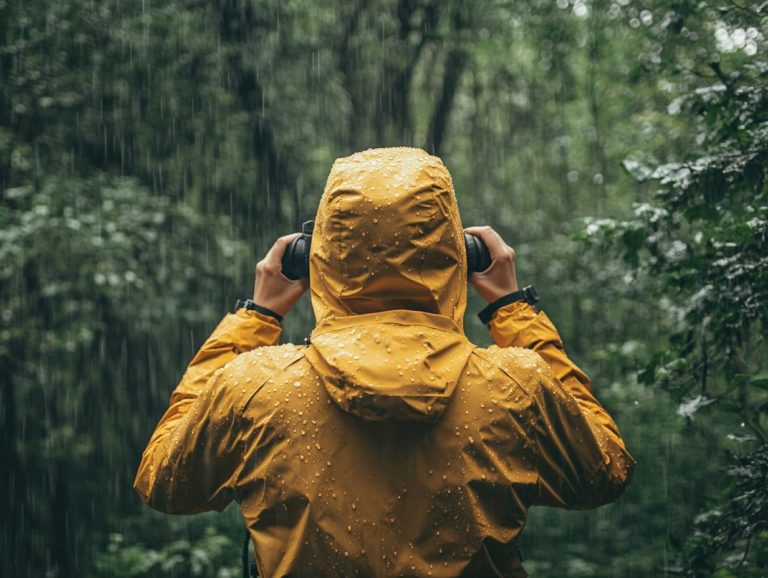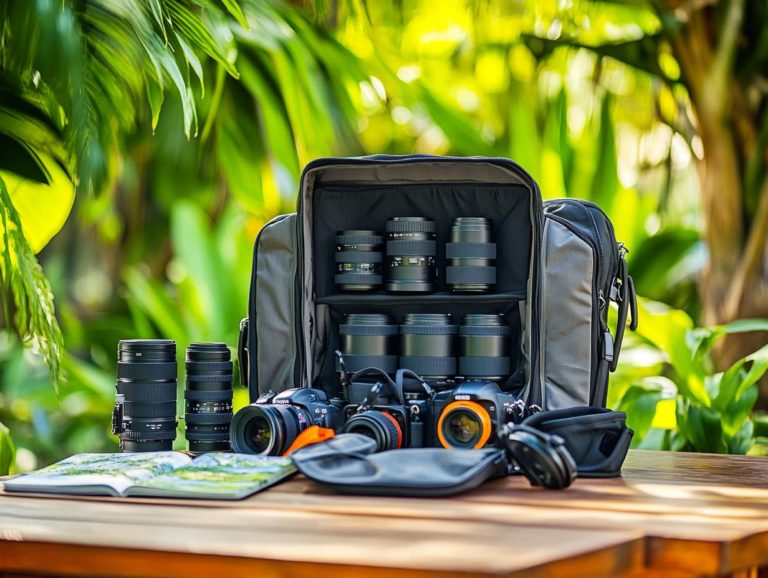Choosing the Right Layers for Bird Watching Comfort
Bird watching can truly be a magical experience, but comfort is essential for savoring those serene moments in nature.
Given the unpredictable nature of the weather, layering your clothing with essential gear is crucial for maintaining comfort throughout your adventure.
Get ready to discover how to layer up for the perfect bird watching adventure! This guide will help you understand weather conditions, the types of layers you need, and how to select the best materials and fits for your outing.
You ll uncover practical tips for effective layering, ensuring your bird watching excursions remain delightful, no matter what the forecast holds.
Are you ready to gear up for your next adventure?
Contents
- Key Takeaways:
- Why Layers are Important for Comfort
- Understanding Weather Conditions
- Types of Layers for Bird Watching
- Factors to Consider When Choosing Layers
- Tips for Layering Effectively
- Frequently Asked Questions
- What are the key factors to consider when choosing layers for birdwatching comfort and the right field guide?
- What type of layers are recommended for birdwatching in cold weather?
- Should I choose lightweight or heavyweight layers for birdwatching?
- Can I mix and match layers from different brands?
- What type of material is best for moisture-wicking layers?
- Are there specific features I should look for in layers for birdwatching comfort?
Key Takeaways:
- Layer up to stay comfortable while bird watching, as weather conditions can change quickly.
- Base layers wick away moisture, insulating layers trap warmth, and outer layers shield from wind and rain.
- When choosing layers, consider material, fit, and functionality for maximum comfort and versatility.
Why Layers are Important for Comfort
When you enjoy bird watching, recognizing the significance of layering your clothing is key for ensuring comfort throughout your adventure. For more insights, check out how to choose the right materials for bird watching.
Layers allow you to adapt to ever-changing temperatures, whether you re hiking through nature reserves or enjoying a leisurely stroll while observing the birds.
By carefully choosing the right combination of base, insulating, and outer layers, you can stay comfortable and focused on your bird encounters. For more insights, check out the ultimate guide to bird watching clothing, ensuring you’re free from the distractions of weather-related discomfort.
This thoughtful approach elevates your bird watching experiences, enriched by quality field guides like the Sibley Birds or the Peterson Field Guide, while ensuring you’re well-prepared for any adventure that comes your way.
Understanding Weather Conditions
Understanding weather conditions is essential for you as someone who loves bird watching, as these elements greatly influence your experiences.
Factors like temperature, humidity, wind, and precipitation play a pivotal role in determining which birds are active and the environments they prefer.
This makes it vital for you to stay informed about the weather. By keeping a close eye on the climate and being prepared for changing conditions, you can enhance your outings.
Staying informed increases your chances of spotting those unique species that make bird watching so rewarding.
How Weather Affects Bird Watching
Weather plays a crucial role in your bird watching adventures, influencing not only the visibility of various species but also their behaviors and feeding patterns.
For instance, overcast days often provide the best conditions for spotting birds, while extreme weather can lead to a noticeable drop in activity.
On sunny days, you might find that birds seek refuge in shaded areas, making them trickier to spot.
However, the vibrant plumage of many species can be absolutely stunning under bright skies, beckoning you to observe.
Gentle rain can stimulate feeding, as many birds thrive in natural reserves under these conditions, eagerly foraging for insects that become more active.
Strong winds can change how birds fly, guiding them closer to shorelines or protective cover, where you might find them congregating, much to the delight of eager bird watchers.
By tuning into these weather nuances, you can significantly enhance your outings, ensuring you make the most of each unique scenario.
Types of Layers for Bird Watching
When preparing for a day of bird watching, grasping the importance of layering is key to ensuring a comfortable and enjoyable experience in the field. Knowing what clothing is best for bird watching can make all the difference.
Each layer plays a vital role: base layers wick away moisture and provide comfort, insulating layers trap warmth effectively, and outer layers shield you from wind and rain.
Choosing the right mix of these layers is crucial, as it enables you to adapt to fluctuating temperatures and conditions. For more insight, check out how to choose versatile bird watching clothing, allowing you to focus fully on the beauty of your bird watching adventures without unnecessary distractions.
Base Layers
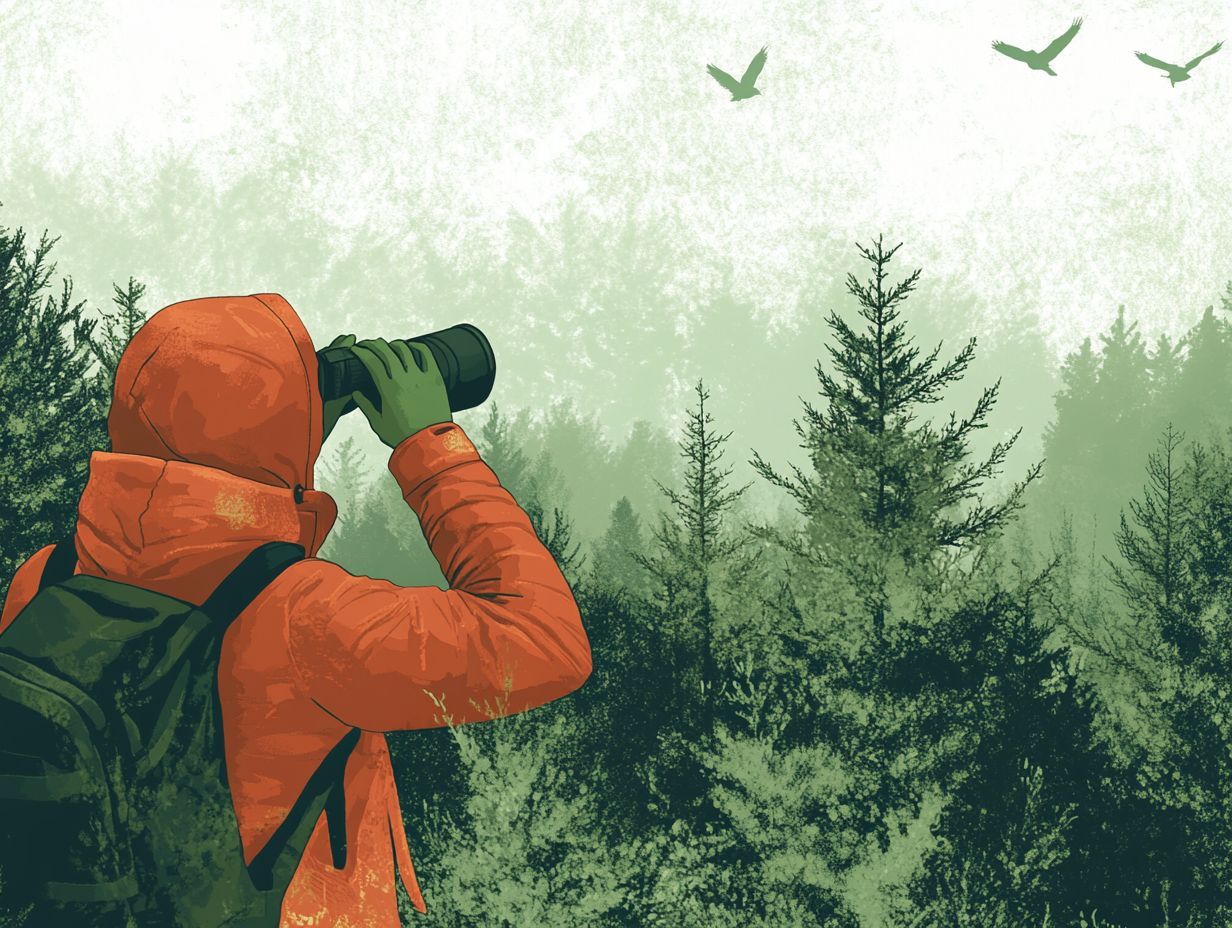
Base layers are essential for ensuring your comfort during birding excursions that may involve a hiking daypack. They provide moisture-wicking properties that help keep you comfortable and dry. These layers keep your skin dry while regulating your body temperature.
Crafted from materials like merino wool or synthetic fabrics, these layers help manage sweat, allowing you to focus on your avian explorations without the annoyance of humidity clinging to your skin. Selecting high-quality base layers is key to an enjoyable birdwatching experience.
These materials offer exceptional insulation and ensure breathability, which is crucial as you transition between varying weather conditions. Brands like Patagonia offer great wool socks designed for birding, while Smartwool is highly regarded for durable base layers, often featuring flatlock seams for added comfort and anti-odor technologies to keep you feeling fresh on long outings.
With effective moisture management and temperature regulation, you can significantly enhance your overall birdwatching experience. This allows you to immerse yourself in nature without the distractions of discomfort or overheating. Investing in reliable base layers can transform a long day of birding into a more enjoyable and productive adventure.
Insulating Layers
Insulating layers play a crucial role in helping you retain body heat during cooler birdwatching outings, allowing you to fully enjoy the great outdoors without feeling the bite of the chill. Lightweight materials like fleece or down offer excellent insulation, making them perfect for layering beneath your outer gear.
By selecting the right insulating layers, you can enhance your comfort, particularly during early morning or late evening birding trips. Among the myriad options available, synthetic insulation has become popular for its moisture-wicking properties, ensuring you stay dry even in damp conditions.
Brands such as Patagonia and The North Face are known for crafting high-quality pieces that integrate advanced technology for optimal warmth and breathability. Choose your insulating layers wisely to make every birdwatching trip enjoyable!
These insulating layers not only provide outstanding thermal efficiency but also allow for the freedom of movement essential for tracking elusive bird species. Opt for pieces with adjustable features to enhance your fit, ensuring warmth and comfort throughout your excursions.
Outer Layers
Outer layers are crucial for protecting you against wind and rain during your birding adventures, allowing you to concentrate on observing wildlife in various habitats instead of wrestling with the weather. Often crafted from breathable, waterproof materials like Gore-Tex a breathable material that keeps you dry while allowing sweat to escape these layers shield you from the elements while ensuring comfort.
Invest in high-quality outer layers today! They are crucial for an unforgettable birding experience. When choosing your outerwear, look for options that expertly blend functionality and durability. Brands like Patagonia and The North Face have earned their reputations for quality and innovation.
Take Patagonia’s Torrentshell jacket, for example its exceptional waterproofing and breathability make it a favorite for long hours in the field. Similarly, The North Face’s Venture 2 jacket combines lightweight materials with effective moisture-wicking properties, ensuring you stay dry and comfortable, even during unexpected downpours.
These features are essential when you re on the hunt for elusive birds in unpredictable weather. They allow you to remain immersed in your passion without distractions from nature s whims.
Factors to Consider When Choosing Layers
When selecting layers for birdwatching, consider several key factors to ensure comfort and functionality during your outdoor adventures, including how to accessorize for bird watching comfort:
- Materials: Choose high-performance fabrics.
- Fit and Comfort: Ensure a comfortable fit for easy movement.
- Overall Effectiveness: Assess how well they perform in different weather conditions.
By carefully evaluating these elements, you can choose clothing that not only elevates your experience but also keeps you focused on the joy of spotting and identifying birds.
Material and Fabric
The selection of materials and fabrics is crucial when choosing layers for birding, as it significantly impacts your comfort and weather resistance. Natural fibers like merino wool and synthetics such as polyester or nylon each come with unique properties that keep you warm, dry, and comfortable during your adventures. Understanding these materials helps you make informed choices about your layering strategy.
For example, merino wool is fantastic for temperature regulation. It wicks moisture away from your skin while providing breathability essential for those all-day birding escapades. On the other hand, polyester shines in quick-drying capabilities and durability. Think of lightweight hiking jackets with outstanding wind resistance. Each material has its own advantages, but some, like cotton, are best left on the shelf due to poor moisture management, which can lead to discomfort and chills.
By considering these factors, you can create your ideal layering strategy for birding needs.
Fit and Comfort
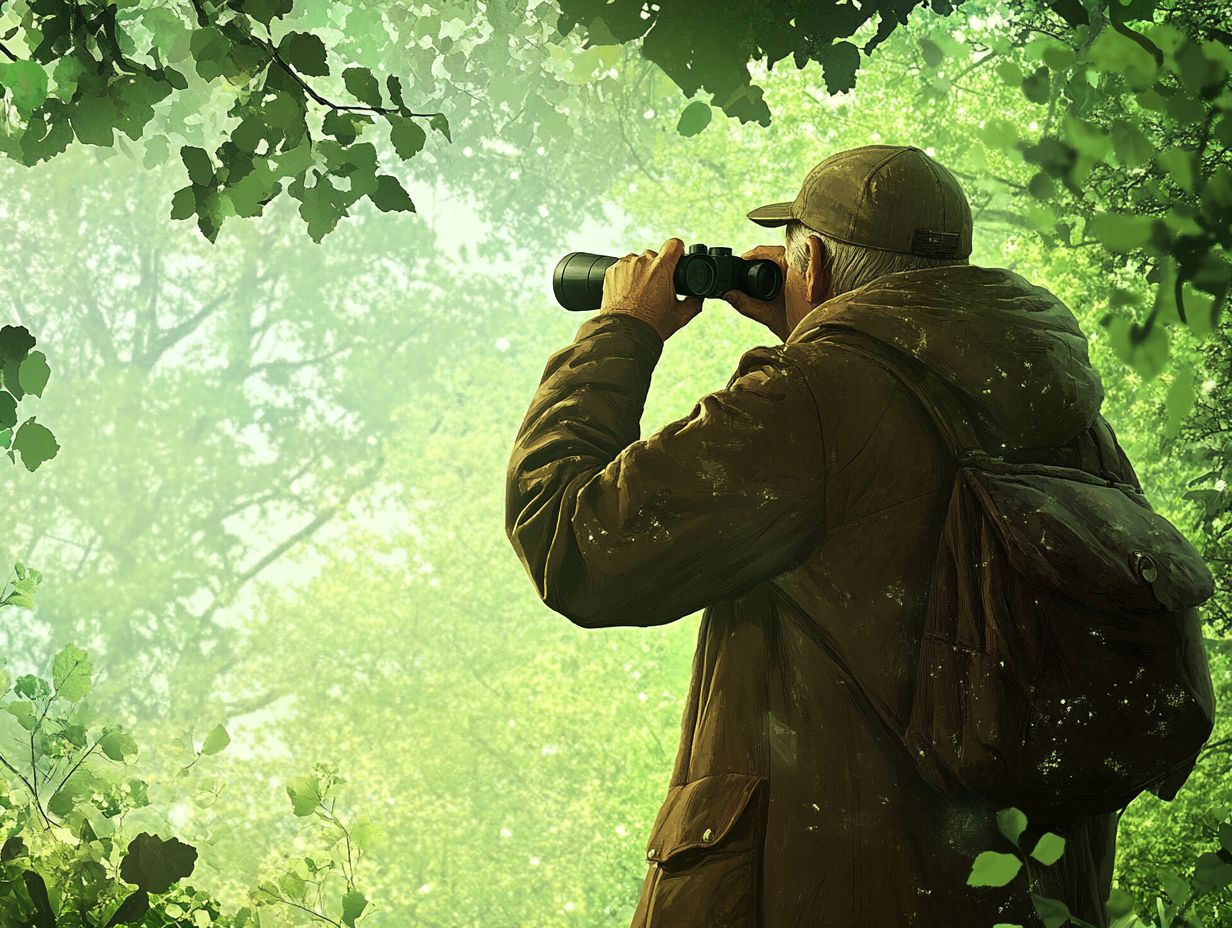
Fit and comfort, along with the right selection of essential gear, are absolutely crucial for your birding apparel. The right fit makes birdwatching more enjoyable and allows for unrestricted movement. If your clothing doesn t fit well, it can easily become a distraction. That s why it s essential to choose garments that cater to various activities, whether you re hiking or standing still to catch a glimpse of a feathered friend.
Selecting the right size and cut can profoundly affect your ability to adapt to different weather conditions and terrains. Breathable fabrics that wick sweat away keep you comfortable during warm outings, while layering options help you stay cozy in cooler environments.
Look for styles that offer flexibility think stretchable materials or adjustable features so you can move freely when reaching for your binoculars or camera. Don t overlook the details; reinforced seams and a comfortable fit around the shoulders can make all the difference during long hours in the field. Ultimately, prioritizing proper fit boosts your comfort and strengthens your connection with the natural world.
Functionality and Versatility
When selecting birding layers, how well your gear works in different situations should be at the forefront of your decision-making. These elements significantly impact how well your outdoor gear adapts to varying weather and activities. For instance, knowing what to look for in bird watching clothing can help you choose layers that serve multiple purposes, like a lightweight jacket that packs neatly into your hiking daypack, which is invaluable for bird watchers on the move. Choosing versatile layers ensures you can easily adjust your attire to meet changing environments.
This level of flexibility enhances your comfort and lets you focus on your primary goal observing wildlife. A waterproof jacket that also provides insulation for chilly evenings can be a game-changer during long days in the field. Multifunctional binoculars with built-in lens cloths or adjustable straps bring convenience without sacrificing portability.
Whether you re navigating humid wetlands or exploring dry woodlands, selecting gear that adapts to various conditions enriches your birdwatching experience. Immerse yourself in nature, free from distractions of ill-suited equipment.
Tips for Layering Effectively
Layering effectively is an essential skill for you as a birdwatcher. Consider including wool socks for added comfort, allowing you to stay adaptable to the ever-changing weather while fully embracing your time outdoors.
By implementing specific layering tips, you can prepare for any situation that may arise during your birding excursions. This means not only choosing the right layers but also mastering the art of combining them, as outlined in how to select the right gear for birding in winter, for optimal performance in the field.
Layering Techniques for Different Weather Conditions
Applying specific layering techniques for varying weather conditions can truly elevate your birdwatching experience and keep you comfortable throughout your adventure. For warmer days, consider how to dress for comfort in bird watching with lightweight base layers paired with breathable outer layers to avoid overheating!
On cooler, windier outings, incorporate insulating layers and windbreakers. By mastering these techniques, you can easily tailor your attire to the day s forecast.
In rainy weather, a waterproof outer layer becomes essential. Pair it with moisture-wicking garments underneath to keep you dry and comfortable. This adaptability helps retain body heat and prevents that annoying clammy feeling that can dampen the joy of observing nature.
The key lies in mixing and matching layers according to the weather. Ensure you have the right combination for easy movement and breatheability of outdoor gear such as Merrell or Salomon shoes. For avid birdwatchers like you, being dressed appropriately for any weather condition means you can fully immerse yourself in the experience, spotting elusive species without discomfort.
Frequently Asked Questions
What are the key factors to consider when choosing layers for birdwatching comfort and the right field guide?
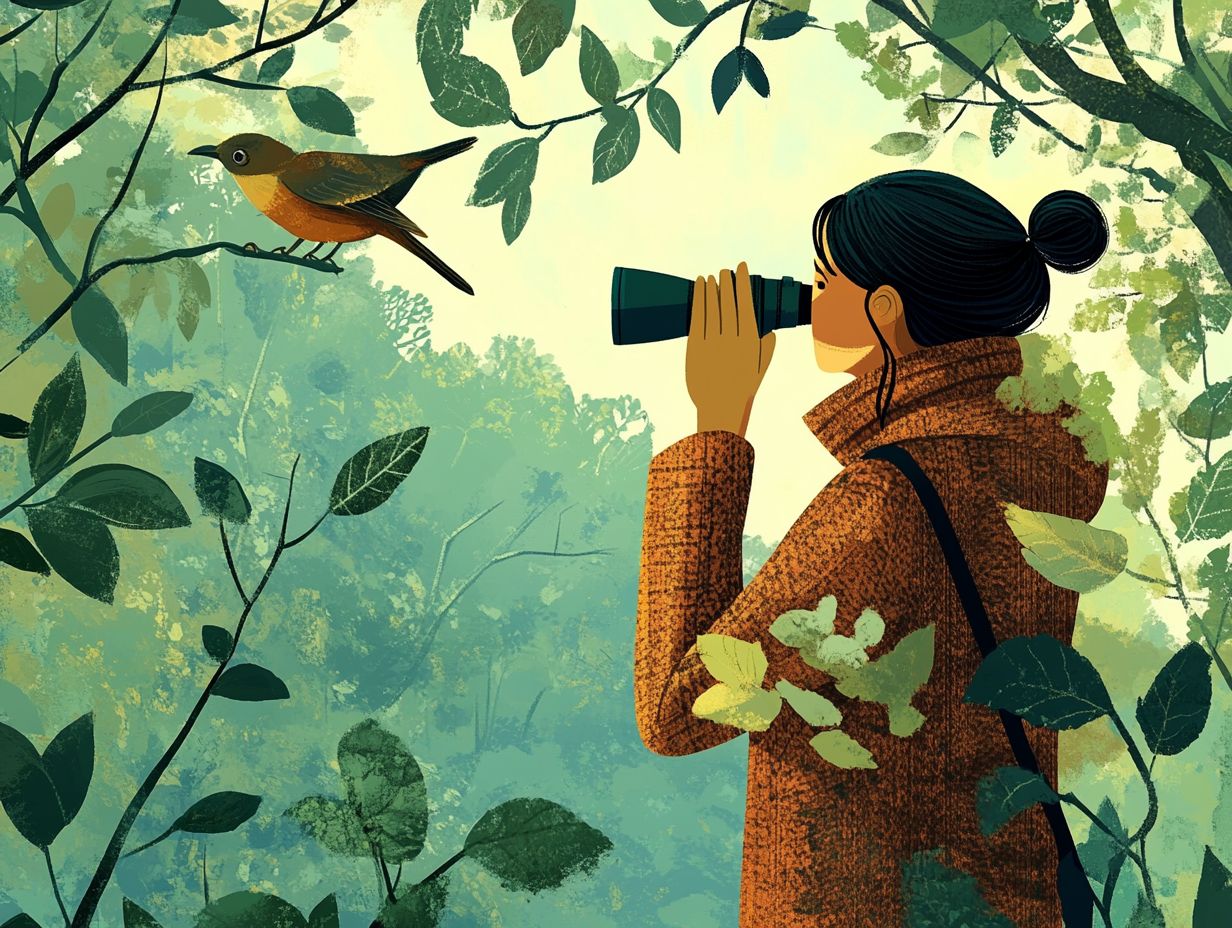
When choosing layers for birdwatching comfort, consider factors such as weather conditions, activity level, and personal preferences for warmth and comfort. Understanding the importance of layering in bird watching will enhance your overall experience!
What type of layers are recommended for birdwatching in cold weather?
For birdwatching in cold weather, wear layers made of insulating materials like fleece or down. A waterproof outer layer is also recommended to protect against wind and rain.
Should I choose lightweight or heavyweight layers for birdwatching?
This depends on the weather conditions and your personal preferences. For milder temperatures, lightweight layers may be sufficient, especially with camouflage clothing. However, heavier layers may provide more warmth and protection in colder climates.
Can I mix and match layers from different brands?
Yes, you can mix and match layers from different brands as long as they serve their intended purpose and fit comfortably together. Trying on different combinations will help you find what works best!
What type of material is best for moisture-wicking layers?
Synthetic materials like polyester and nylon are known for their moisture-wicking properties and are commonly used in base layers for birdwatching. Merino wool is also popular for its ability to regulate body temperature and prevent odors.
Are there specific features I should look for in layers for birdwatching comfort?
Features that may enhance comfort for birdwatching include adjustable hoods, thumbholes in sleeves for added warmth, and pockets for storing small items. Consider which features are most important for your needs!

